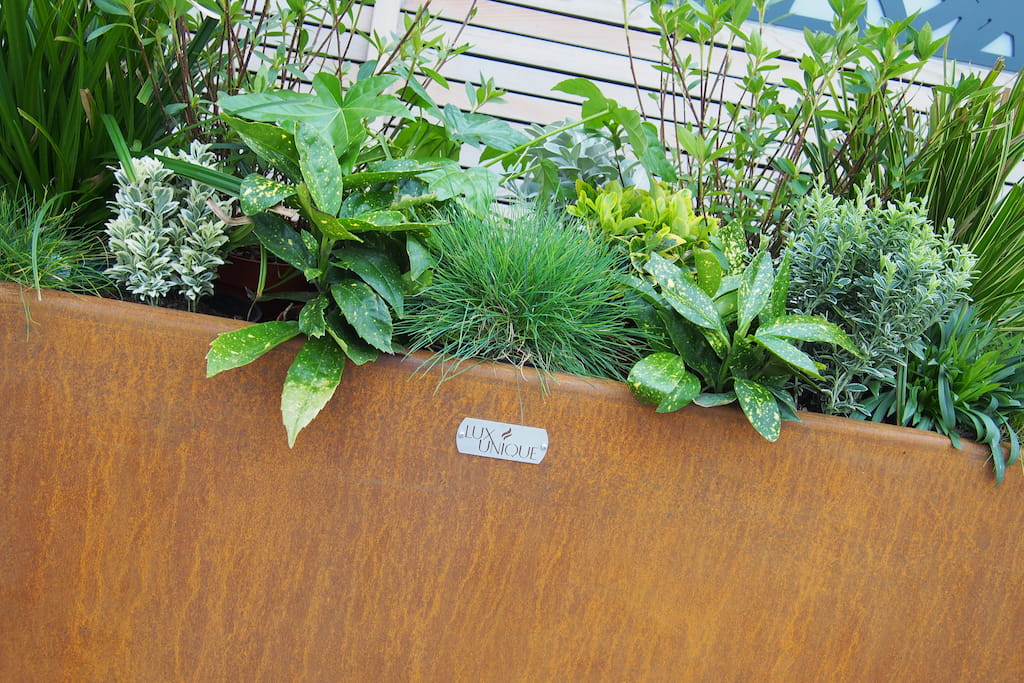Choosing the Right Size and Shape Metal Planter
Choosing the Right Size and Shape Metal Planter
Choosing the right size and shape for your metal planter is important. This is for two main reasons: the aesthetic appeal (how certain sizes and shapes fit into the overall design of your garden or outdoor space) and for plant health reasons (such as the types of plants you are hoping to grow). In this article, we’ll take a more in-depth look at these factors to hopefully help you when choosing a metal plant container for your garden.

Aesthetic considerations
Minimalist vs ornate designs
A simple and clear minimalist design for your plant container can work especially well in a contemporary setting such as a balcony in a city or a small suburban family garden. Perhaps the best example of these is our range of powder-coated metal planters that come in a range of colours including black, white, and pale green.
A more classical or ornate look can be achieved by using a custom planter in a material such as galvanised steel. This can be made to look a lot like the old-fashioned lead planters that can be found in British country homes.
Corten steel is arguably the most versatile of the finishes we offer. Its rustic steel look can be contemporary in some settings but can look quite, well, rustic in others!
Square v round planters
There really are lots of shapes available when it comes to metal planters. The three main ones are round, square, and rectangular, but we also offer bespoke options which means there should be a planter to fit all but the most oddly shaped spots. Bespoke options include L-shaped corner planters, elliptical planters, and hexagonal planters.
Rectangular and square planters are probably best for maximising space because they can be grouped most closely together, which can also make watering them easier. The angular look can work well in modern and more traditional gardens, but is perhaps best suited to the former.
Round pots are more common in more traditional gardens, although they can be made to look good in contemporary ones too. They will lend a slightly more relaxed and gentle feel to your outside space due to their curves which lessen the harshness of sharp edges.
Tapered planters add another option still. They are wider at the top and narrow towards the base which arguably serves to lessen the impact of straight lines and lead the eye even more towards the plants within rather than the planter itself. This is particularly true if you use plants that trail over the edge of the pot.
Uniformity or variety?
If you prefer an ordered, sleek look in your garden then the use of several planters of the same size placed strategically and systematically throughout your garden can help to bring the whole space together. This can add a real cohesion to the design, especially if the planters are all of the same colour.
Alternatively, you may wish to group several planters of different shapes and sizes together to add some extra interest to a planting display on a patio. You could play around with heights and have some tall garden planters as well as some shorter trough planters. You may even wish to mix round and square planters together, although be careful that you don’t add too much variety lest the design begins to look cluttered!
It is probably best not to use too many different materials in a garden, particularly a small one, unless you want to divide the space up into ‘rooms’, in which case the use of one ‘room’ of galvanised steel planters and one of corten steel may help. On the other hand, using the same planters in the different rooms could help you tie radically different planting styles together to create some sort of harmony throughout the garden.
Weight and mobility
Do you want to be able to move your planters around easily and freely? If so, then smaller pots are obviously lighter than larger ones, although most metal pots are quite heavy. Thankfully, you have the option of putting wheels or large feet under your planters. They can then be moved around, either by pushing on a level surface or by using a pallet truck.
Plant health
Plant type
There are shallow-rooted plants and deep-rooted plants, although many plants are not as deep-rooted as you might think. There is also the root span to consider. The roots of a tree, for example, actually spread out quite far and can often reach the width of the canopy on a mature tree. Therefore, a tree will benefit from a relatively large tree planter, although you can underplant the bare soil around the trunk with low-growing plants that might benefit from shade such as ferns.
There are many small trees, or dwarf varieties of trees, that are ideal for pots. You can get patio fruit trees which are grown on a rootstock that keeps the tree small, while many acers are ideal ornamental trees for an area in dappled shade as they have a long season of interest and don’t grow too big.
Shallow-rooted plants such as salad crops and bedding plants can make do with a surprisingly little depth of soil. Six inches would be ample. Ornamental perennials and shrubs are ideal for slightly larger planters. The foliage and flower colour of lavender, for example, contrasts beautifully against the rust colour of corten steel, while oranges and reds such as crocosmia and geum provide a more complementary look.
Maintenance
In general, smaller pots will take more work to keep plants looking their best. This is because the plants won’t have a chance to develop such a good root system as they will be constrained in the container. Also, the volume of compost will be lower so it will dry out more quickly, and the nutrients that the plants need will also deplete more quickly.
They will require more frequent watering, particularly in hot weather in a sunny spot. Flowering plants will benefit from a high-potassium feed such as tomato feed, while most plants will benefit from a more general feed such as a granular fertiliser or a top-dressing with fresh compost or pelleted chicken manure.
For some planting ideas please see our low maintenance plant ideas blog post.
Drainage needs
Some plants like more water than others. Cacti or succulents and other drought-tolerant or drought-loving plants such as lavender, and many others with silver-coloured foliage, don’t like to sit in permanently wet soil, especially in winter. Therefore you can adjust the watering schedule and add grit or similar to the potting medium.
Other plants will appreciate more moisture and are perhaps not ideal for smaller containers where the soil is more prone to drying out. They are also more likely to benefit from being kept out of the midday sun. Salads are a good example of plants that don’t like hot weather and don’t like drying out (despite only needing a smallish pot due to their shallow root system).
Final thoughts on choosing the right size and shape
Generally, same-sized angular pots with a simple surface will help create a more modern and uniform look. Round pots of different shapes and sizes with a more unique finish like corten steel or galvanised steel can help to add interest and a more traditional or complex look to the garden. These are by no means absolute rules, as we have discovered, and so much, as with a lot of design, comes down to personal preference.
Check out our blog for more ideas and advice on choosing the right type planter for your outdoor space or take a look at our range of metal planters to see if you can find one to suit your gardening needs.
